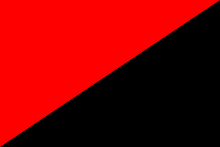Anarcho-syndicalist symbolism

The historically anarcho-syndicalist movement have embraced traditional symbols which represent the union of anarchist ideal (non-state) with labour movement and with socialist projects (communitarian society and collectivist economy).
Black and red bisected symbolism

The 'red-and-black flag' is the symbol of the anarcho-syndicalist and anarcho-communist movements. Black is the traditional color of anarchism, and red is the traditional color of socialism and communism. The red-and-black flag combines the two colors in equal parts, with a simple diagonal split. Typically, the red section is placed on the top-left corner, with the black on the bottom-right corner of the flag. This symbolizes the co-existence of anarchist, socialist, and communist ideals within the anarcho-syndicalism movement, and to symbolize the more socialistic means of the movement leading to a more anarchistic end.
One of the most famous variations of the anarcho-syndicalist flag is that of Spain's Confederación Nacional del Trabajo (National Confederation of Labor, CNT), which still exists today. The CNT, along with the Federación Anarquista Ibérica (Iberian Anarchist Federation, FAI), a major militant faction within the CNT, was a major player in the popular anarchist movements in Spain of the late 19th and early 20th centuries. This group has its own version of the red-and-black flag with its initials on the flag. CNT is in the red, while FAI is in the black– the color of anarchy– as the FAI was founded in 1927 to keep the CNT dedicated to anarchist principles.
Another variation on the red-and-black theme is the red-and-black Africa used mostly by the Zabalaza Anarchist Communist Front (ZACF or ZabFront), an especifista anarchist political organisation in South Africa. The ZACF was inspired by the Organisational Platform of the Libertarian Communists. ZACF members share a basic agreement in terms of theoretical and tactical unity, collective responsibility, and federalism as suggests by the Platform. In historical terms the Platformist tradition starts with The Organizational Platform of the Libertarian Communists, and in the post-war period many include documents like the Georges Fontenis' pamphlet Manifesto of Libertarian Communism.
Black cat

The 'black cat', also called the "wild cat" or "sabot-cat", usually with an arched back and with claws and teeth bared, is closely associated with anarchism, especially with anarcho-syndicalism. It was designed by Ralph Chaplin, who was a prominent figure in the Industrial Workers of the World (IWW). As its stance suggests, the cat is meant to suggest wildcat strikes and radical unionism. The IWW (or the Wobblies) was an important industrial union, and was the first American labor union to recruit and organize women and people of color, and played a critical role in the fight for the eight-hour work day and in free speech fights all over the country in the early 20th century. Their most famous and influential years were from 1905 until they were largely suppressed by the Palmer Raids.
The origin of the black cat symbol is unclear, but according to one story it came from an IWW strike that was going badly. Several members had been beaten up and were put in a hospital. At that time a skinny, black cat walked into the striker's camp. The cat was fed by the striking workers and as the cat regained its health the strike took a turn for the better. Eventually the striking workers got some of their demands and they adopted the cat as their mascot.[1]
The name Black Cat has been used for numerous anarchist-affiliated collectives and cooperatives, including a well-known music venue in Austin, Texas (which was closed following a July 6, 2002 fire) and a now-defunct "collective kitchen" in the University District of Seattle, Washington.
Wooden shoe

The 'wooden shoe' (also known as clog) was used symbolically by anarchists in the 19th and early 20th century, although it has largely faded from use since then. The French word for wooden shoe, sabot is the probable root of the word sabotage: and refers to the tactic by early Dutch unionists of throwing wooden shoes into the gears of factory or farm machinery, effectively stopping work until the equipment could be repaired. The American analogue of this tactic is "monkeywrenching," referring to the similar practice of throwing a monkeywrench in the machinery to damage it and prevent strikebreakers from being able to replace striking union members.
In Philadelphia, Pennsylvania, there is an anarcho-syndicalist bookshop called Wooden Shoe Books, and from 2001 to 2003 there was an anarchist magazine in Denmark called Sabot. There is also an American record label focusing primarily on punk-rock and genres revolving around it called Sabot Productions,[2] which uses exactly the same sabot picture seen on the right as their logo.
A flag depicting a regular leather shoe of a type worn by peasants in the 16th century was carried by the peasants in the German peasants war of 1524-1525, a proto-anarchist rebellion.
See also
References
External links
| Wikimedia Commons has media related to Anarcho-Syndicalism. |